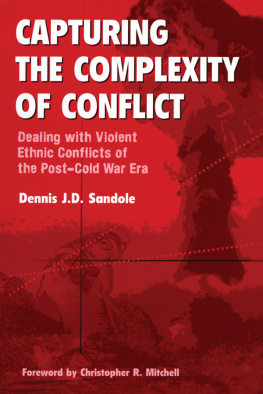First published by Pinter
This edition published in 2012 by Routledge
2 Park Square, Milton Park, Abingdon, Oxon OX14 4RN
711 Third Avenue, New York, NY 10017, USA
Routledge is an imprint of the Taylor & Francis Group, an informa business
Dennis J. D. Sandole 1999
Apart from any fair dealing for the purposes of research or private study or criticism or review, as permitted under the Copyright, Designs and Patents Act 1988, this publication may not be reproduced, stored or transmitted, in any form or by any means or process, without the prior permission in writing of the copyright holders or their agents. Except for reproduction in accordance with the terms of licences issued by the Copyright Licensing Agency, photocopying of whole or part of this publication without the prior written permission of the copyright holders or their agents in single or multiple copies whether for gain or not is illegal and expressly forbidden. Please direct all enquiries concerning copyright to the publishers.
British Library Cataloguing-in-Publication Data
A catalogue record for this book is available from the British Library.
ISBN 1-85567-618-4 (hardback)
1-85567-619-2 (paperback)
ISBN 978-1-8556-7619-0 (pbk)
Library of Congress Cataloging-in-Publication Data
Sandole, Dennis J. D., 1941
Capturing the complexity of conflict: dealing with violent ethnic conflicts in the post-Cold War era / by Dennis J. D. Sandole; foreword by Christopher R. Mitchell.
p. cm.
Includes bibliographical references (p.) and index.
ISBN 1855676184 (Hardback). ISBN 1855676192 (Paperback)
1. Social conflict. 2. Social conflictSimulation methods. 3. Conflict management. 4. Pacific settlement of international disputes. 5. Ethnic relations. 6. War. I. Title. HM136.S245 1999
303.6dc21
9911397
CIP
The Institute for Conflict Analysis and Resolution (ICAR) was originally established as an academic center at George Mason University in Virginia, but the intentions of its founders were rather different from those underlying the setting up of many other university research institutions. Quite deliberately, one of the stated tasks of the Institute was to develop theories about the origins, dynamics and ending of conflicts, but to ensure that this would be relevant and usable theory, so that the actual practice of conflict resolution by ICAR members and others could be informed by the latest ideas about how conflicts developed and how they might best be resolved. In the words of one of the pioneers of our field, Kurt Lewin, the conception was to produce useful intellectual tools for practical theorists.
My colleague, Dennis Sandole, was one of the first scholars to be appointed to the faculty of the Institute, and Capturing the Complexity of Conflict is the third book he has published under its auspices. As such, it is an admirable fulfillment of the wishes of the founders of the Institute, in that it combines broad and formidable scholarship with a consideration of some of the practical implications of its findings and a number of recommendations for future action, especially as regards the growing number of violent and intractable intra-society conflicts that have, in the past decade, emerged from a latent condition to make a mockery of any ideas about the ending of history. Capturing the Complexity of Conflict is thus as much about the Bosnias, the Northern Irelands, the Somalias and the Nagorno Karabakhs of this world as it is about the Kuwaits, the Falklands/Malvinas or the Peru/Ecuador border dispute.
One of the great strengths of the book is the way in which the author uses a variety of approaches (triangulation, in the fashionable phrase) to throw light on the reasons for wars and other forms of large-scale and violent conflicts starting, escalating and continuing for long periods of time. (The latter is a particularly important aspect of this work, as Sandole helps to illuminate the psycho-social dynamics which operate to ensure that conflicts persist over generations, and how they can be revived from a dormant condition by leaders who for their own reasons know how to manipulate the right signs, symbols and historical memories.) Sandole surveys the disparate literature on wars, both empirical and theoretical, in developing a three-level taxonomy of types of explanation for the onset and continuation of wars and civil strife decisionmaking, societal and trans-societal levels. The taxonomy draws upon but elaborates and improves Kenneth Waltzs familiar three images of the origins of war, but it includes much of the recent work by scholars such as, for example, Volkan and Kelman on the psychodynamics of conflict, and it enables the author to develop a 23-variable model of key influences on large-scale human conflict.
Sandole then recounts and analyzes data from a series of simulations based upon the somewhat misleadingly named Prisoners Dilemma Simulation (itself an elaboration of such large-scale role-playing simulations as Guetzkows Internation Simulation and Smokers International Process Simulation), mounting en route a vigorous and convincing defense of the use of simulation to incorporate empirically based theories of conflict into increasingly complex models; and to provide an alternative and additional check on the relevance and validity of those theories. He then matches the findings from the simulation series with empirical data available from comparative studies of wars from that of Quincy Wright (1942) onward, and highlights areas of strong agreement between and within both sets of evidence.
In this part of the work, some of the most interesting findings have to do with the way in which different variables come into play (and have a major impact) at different developmental stages of conflicts, with the implication that we need alternative theories (and hence remedies) for understanding the dynamics of conflicts depending upon whether we are dealing with the escalatory or continuity stages of a dispute. Another interesting and counter-intuitive argument put forward by Sandole, but supported by his data and much other evidence, is the relatively low influence of decision-making variables once the conflict has become protracted and developed dynamics of its own that resist efforts to ameliorate, manage or resolve it. This contrast between conflict as start up and conflict as process is one which has been hinted at in much of the literature, but Sandoles discussion of the difference is both thorough and persuasive.
For practitioners, however, the most interesting part of Capturing the Complexity of Conflict will be the concluding chapters, in which Sandole takes his theoretical findings back into the real world of the 1990s mainly Europe of the 1990s and investigates how our best theories about the dynamics of protracted conflicts might be used in order to remove the causes of such conflict while they remain in their dormant state (provention rather than prevention in a term he has borrowed from John Burton). He carries out a thorough survey of the origins and development of the Organization for Security and Co-operation in Europe (OSCE), with its emphasis on confidence- and security-building measures, and argues for the strengthening of its conflict resolution capacities, especially in a pre-emptive mode. Perhaps this is the least persuasive part of the book, knowing the speed with which most intergovernmental institutions adapt themselves, and the OSCEs record to date in places such as the former Yugoslavia is not impressive. However, Sandole is realist enough (with a small r) to acknowledge the OSCEs shortcomings and to argue for a more complex approach to conflict resolution. This involves the coordinated use of an array of institutions and processes tailored to the need to deal with an equally complex array of factors that ensure the continuation of violent conflicts. What he calls a New European Peace and Security System (NEPSS) involves efforts by governments, international governmental organizations (such as OSCE, an expanded NATO and the Council of Europe), development and aid agencies, unofficial Track 2 interveners and human rights organizations to work in a coordinated manner integrated systems of conflict resolution networks in order to deal with the complex of psychological, social, political and economic variables that move a conflict from a dormant to a manifest stage and continue to drive it once the conflict as start up stage is passed. There is a great deal here that is worth practical consideration, but the great strength of Sandoles argument is that it is based in the best findings of his and many others theoretical answers to the question: why do wars start up and why do they persist and protract over time?








